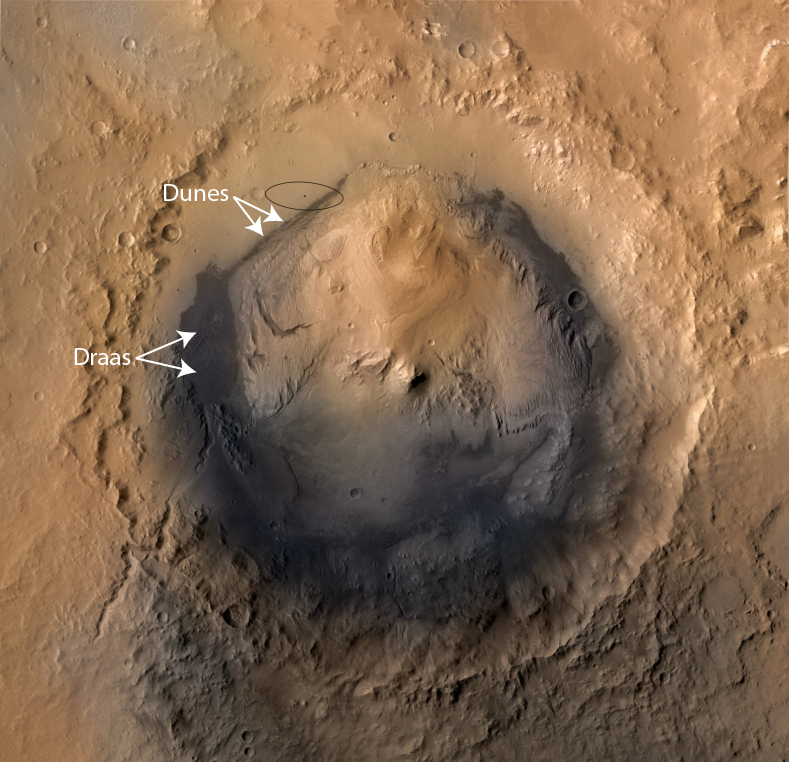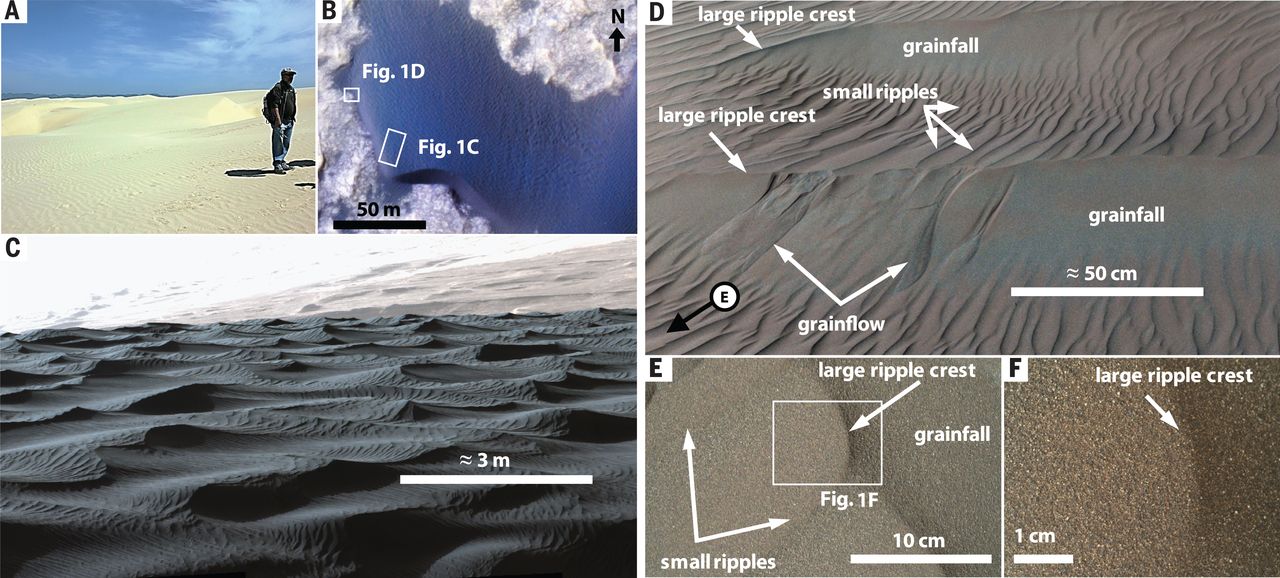3.1.5: Bedforms in Eolian Dunes on Mars (vs Earth)
- Page ID
- 2798
\( \newcommand{\vecs}[1]{\overset { \scriptstyle \rightharpoonup} {\mathbf{#1}} } \)
\( \newcommand{\vecd}[1]{\overset{-\!-\!\rightharpoonup}{\vphantom{a}\smash {#1}}} \)
\( \newcommand{\id}{\mathrm{id}}\) \( \newcommand{\Span}{\mathrm{span}}\)
( \newcommand{\kernel}{\mathrm{null}\,}\) \( \newcommand{\range}{\mathrm{range}\,}\)
\( \newcommand{\RealPart}{\mathrm{Re}}\) \( \newcommand{\ImaginaryPart}{\mathrm{Im}}\)
\( \newcommand{\Argument}{\mathrm{Arg}}\) \( \newcommand{\norm}[1]{\| #1 \|}\)
\( \newcommand{\inner}[2]{\langle #1, #2 \rangle}\)
\( \newcommand{\Span}{\mathrm{span}}\)
\( \newcommand{\id}{\mathrm{id}}\)
\( \newcommand{\Span}{\mathrm{span}}\)
\( \newcommand{\kernel}{\mathrm{null}\,}\)
\( \newcommand{\range}{\mathrm{range}\,}\)
\( \newcommand{\RealPart}{\mathrm{Re}}\)
\( \newcommand{\ImaginaryPart}{\mathrm{Im}}\)
\( \newcommand{\Argument}{\mathrm{Arg}}\)
\( \newcommand{\norm}[1]{\| #1 \|}\)
\( \newcommand{\inner}[2]{\langle #1, #2 \rangle}\)
\( \newcommand{\Span}{\mathrm{span}}\) \( \newcommand{\AA}{\unicode[.8,0]{x212B}}\)
\( \newcommand{\vectorA}[1]{\vec{#1}} % arrow\)
\( \newcommand{\vectorAt}[1]{\vec{\text{#1}}} % arrow\)
\( \newcommand{\vectorB}[1]{\overset { \scriptstyle \rightharpoonup} {\mathbf{#1}} } \)
\( \newcommand{\vectorC}[1]{\textbf{#1}} \)
\( \newcommand{\vectorD}[1]{\overrightarrow{#1}} \)
\( \newcommand{\vectorDt}[1]{\overrightarrow{\text{#1}}} \)
\( \newcommand{\vectE}[1]{\overset{-\!-\!\rightharpoonup}{\vphantom{a}\smash{\mathbf {#1}}}} \)
\( \newcommand{\vecs}[1]{\overset { \scriptstyle \rightharpoonup} {\mathbf{#1}} } \)
\( \newcommand{\vecd}[1]{\overset{-\!-\!\rightharpoonup}{\vphantom{a}\smash {#1}}} \)
\(\newcommand{\avec}{\mathbf a}\) \(\newcommand{\bvec}{\mathbf b}\) \(\newcommand{\cvec}{\mathbf c}\) \(\newcommand{\dvec}{\mathbf d}\) \(\newcommand{\dtil}{\widetilde{\mathbf d}}\) \(\newcommand{\evec}{\mathbf e}\) \(\newcommand{\fvec}{\mathbf f}\) \(\newcommand{\nvec}{\mathbf n}\) \(\newcommand{\pvec}{\mathbf p}\) \(\newcommand{\qvec}{\mathbf q}\) \(\newcommand{\svec}{\mathbf s}\) \(\newcommand{\tvec}{\mathbf t}\) \(\newcommand{\uvec}{\mathbf u}\) \(\newcommand{\vvec}{\mathbf v}\) \(\newcommand{\wvec}{\mathbf w}\) \(\newcommand{\xvec}{\mathbf x}\) \(\newcommand{\yvec}{\mathbf y}\) \(\newcommand{\zvec}{\mathbf z}\) \(\newcommand{\rvec}{\mathbf r}\) \(\newcommand{\mvec}{\mathbf m}\) \(\newcommand{\zerovec}{\mathbf 0}\) \(\newcommand{\onevec}{\mathbf 1}\) \(\newcommand{\real}{\mathbb R}\) \(\newcommand{\twovec}[2]{\left[\begin{array}{r}#1 \\ #2 \end{array}\right]}\) \(\newcommand{\ctwovec}[2]{\left[\begin{array}{c}#1 \\ #2 \end{array}\right]}\) \(\newcommand{\threevec}[3]{\left[\begin{array}{r}#1 \\ #2 \\ #3 \end{array}\right]}\) \(\newcommand{\cthreevec}[3]{\left[\begin{array}{c}#1 \\ #2 \\ #3 \end{array}\right]}\) \(\newcommand{\fourvec}[4]{\left[\begin{array}{r}#1 \\ #2 \\ #3 \\ #4 \end{array}\right]}\) \(\newcommand{\cfourvec}[4]{\left[\begin{array}{c}#1 \\ #2 \\ #3 \\ #4 \end{array}\right]}\) \(\newcommand{\fivevec}[5]{\left[\begin{array}{r}#1 \\ #2 \\ #3 \\ #4 \\ #5 \\ \end{array}\right]}\) \(\newcommand{\cfivevec}[5]{\left[\begin{array}{c}#1 \\ #2 \\ #3 \\ #4 \\ #5 \\ \end{array}\right]}\) \(\newcommand{\mattwo}[4]{\left[\begin{array}{rr}#1 \amp #2 \\ #3 \amp #4 \\ \end{array}\right]}\) \(\newcommand{\laspan}[1]{\text{Span}\{#1\}}\) \(\newcommand{\bcal}{\cal B}\) \(\newcommand{\ccal}{\cal C}\) \(\newcommand{\scal}{\cal S}\) \(\newcommand{\wcal}{\cal W}\) \(\newcommand{\ecal}{\cal E}\) \(\newcommand{\coords}[2]{\left\{#1\right\}_{#2}}\) \(\newcommand{\gray}[1]{\color{gray}{#1}}\) \(\newcommand{\lgray}[1]{\color{lightgray}{#1}}\) \(\newcommand{\rank}{\operatorname{rank}}\) \(\newcommand{\row}{\text{Row}}\) \(\newcommand{\col}{\text{Col}}\) \(\renewcommand{\row}{\text{Row}}\) \(\newcommand{\nul}{\text{Nul}}\) \(\newcommand{\var}{\text{Var}}\) \(\newcommand{\corr}{\text{corr}}\) \(\newcommand{\len}[1]{\left|#1\right|}\) \(\newcommand{\bbar}{\overline{\bvec}}\) \(\newcommand{\bhat}{\widehat{\bvec}}\) \(\newcommand{\bperp}{\bvec^\perp}\) \(\newcommand{\xhat}{\widehat{\xvec}}\) \(\newcommand{\vhat}{\widehat{\vvec}}\) \(\newcommand{\uhat}{\widehat{\uvec}}\) \(\newcommand{\what}{\widehat{\wvec}}\) \(\newcommand{\Sighat}{\widehat{\Sigma}}\) \(\newcommand{\lt}{<}\) \(\newcommand{\gt}{>}\) \(\newcommand{\amp}{&}\) \(\definecolor{fillinmathshade}{gray}{0.9}\)Eolian Landforms and Bedforms in Gale Crater
There are multiple scales of eolian landforms and bedforms in Gale Crater (Figure 1). The largest scale is the erg (a large area covered in eolian sand) that extends along the sides and south end of Mount Sharp in Gale Crater (link to figure of whole crater annotated with eolian bed/landforms). The next smaller scale of bedforms is draas (Figure 2), which are undulations in the erg that have a length scale of hundreds of meters to kilometers. Two can be seen in the large sandy area west of Mount Sharp. The draas are composed of dunes, which range from 3 m to 600 m in wavelength. The dunes have several different morphologies. On Mars, megaripples with 0.8 to 3 m wavelengths are common on many dunes. Impact ripples with wavelength of centimeters to about 20 cm (Lapotre et al., 2018) are very common. These impact ripples are similar to the ones that migrate on dune slopes on Earth.

Figure 1: Satellite image of Gale Crater, which is ~150 km in diameter. The black areas consist of sand that has been actively transported by wind in modern times. The area covered by sand is large enough to be considered an erg. Bedforms visible at this scale include draas and individual dunes.

Figure 2: A higher resolution image of the area labeled "Draas" in Figure 1 with dunes and the draa crest regions labeled. Taken with the HiRISE camera. A full resolution version is available as are other forms of the image. Image credit: NASA/JPL/University of Arizona/Sumner
Martian Megaripples - A New Beform Type
Some martian sand dunes have bedforms that are not observed on Earth. Specifically, the megaripples, roughly 3 meters apart, are not seen on Earth nor have they been previously recognized as a distinct type of bedform on Mars. Wind grain transport on Earth produces decimeter-wavelength ripples and hundred-meter– to kilometer-wavelength dunes. Similar bedforms also form from wind on Mars. However, a third stable bedform with meter-scale wavelengths is stable on Mars. These bedforms typically have sinuous crestlines (unlike smaller ripples and larger dunes) as well as asymmetric profiles with lee slopes that are sometimes slip faces at the angle of repose. There is a gap in size between the small wind ripples, the new megaripples, and the dunes (Lapotre et al., 2018). These gaps in size suggest that the formation of the megaripples is controlled by different wind-grain interactions than either the small ripples or the dunes. The specific interactions that form them are controversial. To some, these new bedforms resemble fluid-drag ripples, which form in water on Earth when the laminar sublayer at the base of the flow is very thick due to a low flow speed (Lapotre et al., 2018). Lapotre, et al. (2016) speculate that the low atmospheric pressure of Mars creates the equivalent of a very thick laminar sublayer. However, this model has not yet been generally accepted by the sedimentology community.

Figure 3: Figure 1 from Lapotre, et al. (2016). A) Dunes and ripples at Oceano Dunes, CA, lack the megaripples seen on some dunes on Mars. B) Satellite image of Namib dune showing the locations of figures. Taken by the HiRISE camera. C) Part of the image shown in Figure 1. D) Image showing the megaripples (called large ripples in the figure) and small ripples on the side of Namib dune. E) and F) The sand forming the megaripples.

Figure 4: Megaripples on the back of Namib dune taken during Phase 1 of the Bagnold dunes investigation with a scale bar. Image credit: NASA/JPL-Caltech/MSSS


